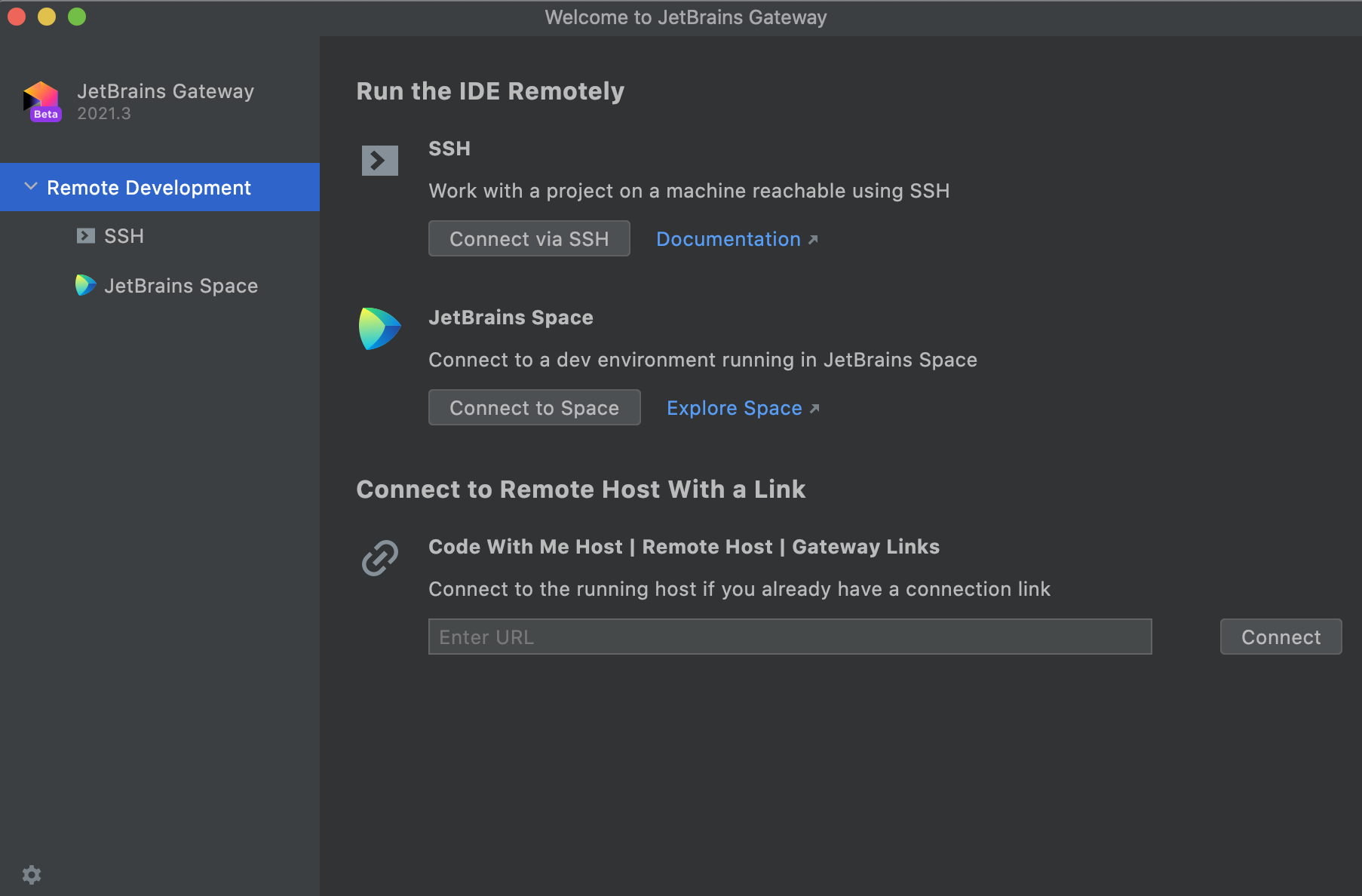Remote developmentProfessional
Since working remotely became a necessity, PyCharm offers the Remote Development functionality to help you code, run, debug, and deploy your projects remotely.
Prerequisites
Before you start developing on the remote machine, make sure you have the following:
Remote machine (a target for an IDE) meets the minimum recommended requirements that can be found in IDEs articles.
note
Since JetBrains Client is a thin client lightweight application, the requirements for disk space and computer resources are lower than for a host.
You have installed a compatible SSH server on the Linux platform.
note
The server part is self-contained, so no special dependencies should be installed. It will also run on any
glibc-based Docker image (that is, not on Alpine).The Linux platform has any recent Linux AMD64 distribution such as Ubuntu 16.04+, RHEL/Centos 7+, and so on. There is no arm64 support yet. We recommend using machines with 2+ cores, 4GB+ of RAM, and 5GB+ of disk space.
You need to have the sftp subsystem enabled on the remote host. In the current implementation, we use it for the backend deployment.
Connection from PyCharm
The connection to a remote sever is done via SSH and can be started right from the welcome screen of PyCharm.
note
Make sure you have the Remote Development Gateway plugin installed and enabled.
Also, make sure that the remote server prerequisites are met.
Connect to a remote server and open the remote project
On the PyCharm welcome screen, select Remote Development.
In the Run the IDE Remotely section, click Connect via SSH.
If you have the IDE already running on the remote server and you have a connection link, you can use the Connect to Remote Host With a Link section.
Configure the remote server connection parameters and click Check Connection and Continue to make sure the connection to the remote server is successful.

On the next page of the wizard, in the IDE version field, select the source of the remote IDE that you want to use.
Use one of the following ways to get an IDE installer:
Automatically fetch from JetBrains installers storage -default variant.
Your remote server must have a network connection to JetBrains URLs:
https://code-with-me.jetbrains.com https://download.jetbrains.com https://download-cf.jetbrains.com https://cache-redirector.jetbrains.comFetch from your company's internal storage. In this case, you need to click Other options and select Use download link. It is helpful if remote machines don't have an Internet connection to JetBrains' websites or your organization uses some custom builds.
Upload from your local machine. In this case, click Other options and select Upload installer file. You need to get the IDE
.tar.gzarchive from the JetBrains website by yourself in advance.
note
Since PyCharm versions 2022.1+, you can also select a custom path on the remote side for theunpacked backend installer. Use this option if a default directory doesn't have enough space.

Click Download and Start IDE.
PyCharm starts JetBrains Gateway, which downloads the IDE backend, launches, and opens JetBrains Client with your project.
For the information on how to start working with a separate JetBrains Gateway installer, refer to JetBrains Gateway.
On how to add plugins, SDK, and work in an opened remote project, refer to the appropriate Getting Started section.
JetBrains Gateway is used as an entry point to connect to a remote server via SSH. It launches JetBrains Client, which is a thin client that enables you to work with your remote project.

You can use one of the following ways to launch JetBrains Gateway:
Use PyCharm and the enabled Remote Development Gateway plugin in it. In this case, when you open the PyCharm welcome screen, the Remote Development option will be available immediately and you can connect to your remote server using SSH.

Install JetBrains Gateway using the JetBrains Toolbox App.

Manually download and install JetBrains Gateway app.
Depending on your local OS, use one of the following installers:
macOSmacOS Apple SiliconWindowsLinuxDownload the JetBrains Gateway 2021.3 .dmg.
Download the JetBrains Gateway 2021.3.dmg.
Download the JetBrains Gateway 2021.3 .exe.
Download the JetBrains Gateway 2021.3 .tar.gz.
Licensing
JetBrains Gateway itself is a free application. However, you should have a license for the remote IDE.
The licensing for Remote Development is handled on the local machine and is covered by your existing active IDE license.
No license information is passed to or saved on the remote server. You can start the IDE backend without entering the license information since JetBrains Gateway is a free application.
The license will be checked later when you connect to the launched IDE backend. Product in the license on your local machine must match the remote backend IDE. If you use a corporate floating license server, that's your local (client) machine, which must be able to reach this server. In this context nothing is changed from the same local PyCharm mechanism.
Useful links
For the information on how to configure the Remote Development environment and open your project, refer to Getting started with remote development.
If you want to see the detailed information about the Remote Development architecture and definitions, refer to Remote development overview and FAQ about remote development.
If you have encountered problems, contact the Remote Development support (support@jetbrains.com) or create an issue/report in our YouTrack
Thanks for your feedback!